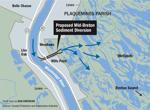Louisiana has revised its plans to move as much as 75,000 cubic feet of muddy water per second from the Mississippi River into Breton Sound, in order to keep the proposed $800 million Mid-Breton Sediment Diversion within budget and reduce the chance of flooding roads and fishing camps outside the levee. Instead, the project is being designed for a maximum 50,000 cfs.
“As we progress with these projects and start looking at their costs, benefits, we are right-sizing these projects to fit into the [coastal restoration] program,” Chip Kline, chairman of the state's Coastal Protection and Restoration Authority. “We’re not making these decisions in a vacuum.”

The proposed Mid-Breton Sediment Diversion on the east bank of Plaquemines Parish at Wills Point is being designed to move water and sediment from the Mississippi River into Breton Sound, to maintain existing wetlands and build new land.
The diversion would be built just south of Wills Point on the east bank of the Mississippi River in Plaquemines Parish, in hopes of building 31 square miles of new land in Breton Sound and bolstering this part of Louisiana's fragile coast. It's about 30 percent designed, diversions program manager Brad Barth told the coastal authority's governing board on Wednesday.
The most recent update of the state’s Coastal Master Plan, in 2017, called for the diversion to have a maximum flow of 75,000 cfs, the same as is proposed for the Mid-Barataria Sediment Diversion on the river’s west bank near Myrtle Grove. When first added to the master plan in 2012, the Mid-Breton diversion had a maximum flow of only 35,000 cfs.
The maximum flow would occur when the river’s flow upstream at Belle Chasse exceeds 1 million cfs. The diversion gates would not be opened at all until the river flow reaches 450,000 cfs.

An illustration released Wednesday, Nov. 17, 2021, shows the latest design for the proposed Mid-Barataria Sediment Diversion, which would funnel a maximum 75,000 cubic feet per second of sediment and water from the Mississippi River into the Barataria Basin.
Both diversions have been criticized by fishers and oyster growers because the freshwater carrying the sediment into the brackish water of Barataria Bay and Breton Sound would hamper their livelihood.
The Mid-Breton diversion has also been opposed by Mississippi officials, who cite the damaging effects of opening the Bonnet Carre Spillway on the Mississippi Sound. They fear similar results from Mid-Breton. Louisiana Lt. Gov. Billy Nungesser, an opponent of both diversions, gave speeches in Mississippi this year to repeat the concerns voiced by Mississippi officials.
During the two openings of the Bonnet Carre Spillway in 2019, which were ordered by the Army Corps of Engineers to avoid the river topping its levees in New Orleans, more than 300,000 cfs of water was released into Lake Pontchartrain at times. The water then filtered across the lake and flowed through the Rigolets and Chef Menteur passes into the Mississippi Sound.
Louisiana officials in the past have said Mid-Breton modeling at 75,000 cfs did not show such effects on the Mississippi Sound, in part because the diversion water would be flowing into Breton Sound well south of the Mississippi Sound. They also said plans to operate the diversion will take into account issues such as opening the spillway.
Barth said the lower, 50,000 cfs flow of sediment and water will still create as much as 20,000 acres, about 31 square miles, of new land, based on modeling used in the design phase of the project. At 35,000 cfs, the diversion would have created 15,000 acres, 23 square miles, of new land. At 75,000 cfs, it would have created more than 30,000 acres, about 47 square miles.
“Overall, a potential 50,000 cfs sediment diversion planned for Mid-Breton will significantly benefit the estuary and support the goals of CPRA and the Coastal Master Plan,” Barth said.
Barth also said the timelines for final approval of permits and the beginning of construction for both diversions have slipped, both because of the effects of the COVID-19 pandemic and, in the case of Mid-Breton, to allow for additional environmental review.
The draft environmental impact statement for Mid-Breton is now expected in August 2023, a nine-month delay, with a final statement release in the fall of 2024. That would be followed by final permit decisions by the Army Corps of Engineers in November 2024. Construction could begin at some point after that.
The draft statement for the Mid-Barataria diversion was released in March. The Corps received 50,000 comments, each of which requires a response.
The final version of the Mid-Barataria environmental statement won’t be released until next summer, followed by another period for public comments before the Corps makes final decisions on the construction permits.
"flow" - Google News
November 20, 2021 at 05:00PM
https://ift.tt/3nAEljT
Less water to flow through Mid-Breton Sediment Diversion, Louisiana coastal officials say - NOLA.com
"flow" - Google News
https://ift.tt/2Sw6Z5O
https://ift.tt/2zNW3tO
Bagikan Berita Ini
















0 Response to "Less water to flow through Mid-Breton Sediment Diversion, Louisiana coastal officials say - NOLA.com"
Post a Comment